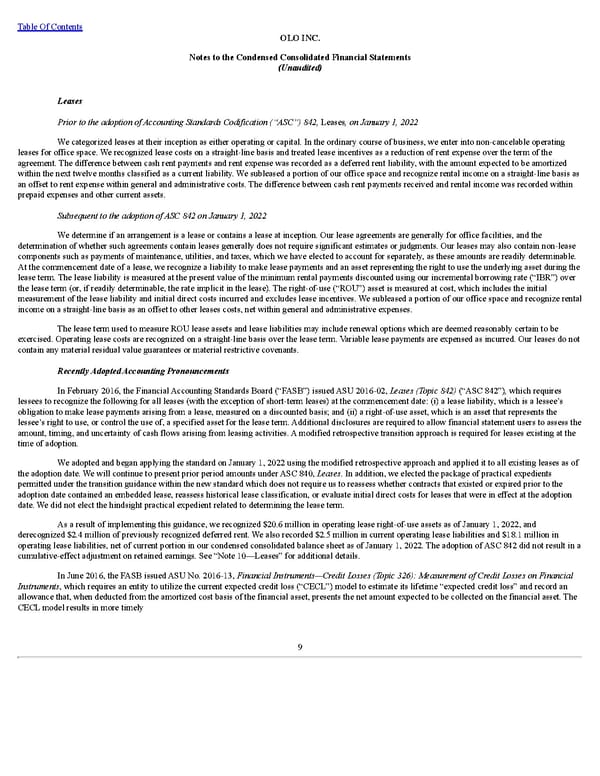Table Of Contents OLO INC. Notes to the Condensed Consolidated Financial Statements (Unaudited) Leases Prior to the adoption of Accounting Standards Codification (“ASC”) 842, Leases , on January 1, 2022 We categorized leases at their inception as either operating or capital. In the ordinary course of business, we enter into non-cancelable operating leases for office space. We recognized lease costs on a straight-line basis and treated lease incentives as a reduction of rent expense over the term of the agreement. The difference between cash rent payments and rent expense was recorded as a deferred rent liability, with the amount expected to be amortized within the next twelve months classified as a current liability. We subleased a portion of our office space and recognize rental income on a straight-line basis as an offset to rent expense within general and administrative costs. The difference between cash rent payments received and rental income was recorded within prepaid expenses and other current assets. Subsequent to the adoption of ASC 842 on January 1, 2022 We determine if an arrangement is a lease or contains a lease at inception. Our lease agreements are generally for office facilities, and the determination of whether such agreements contain leases generally does not require significant estimates or judgments. Our leases may also contain non-lease components such as payments of maintenance, utilities, and taxes, which we have elected to account for separately, as these amounts are readily determinable. At the commencement date of a lease, we recognize a liability to make lease payments and an asset representing the right to use the underlying asset during the lease term. The lease liability is measured at the present value of the minimum rental payments discounted using our incremental borrowing rate (“IBR”) over the lease term (or, if readily determinable, the rate implicit in the lease). The right-of-use (“ROU”) asset is measured at cost, which includes the initial measurement of the lease liability and initial direct costs incurred and excludes lease incentives. We subleased a portion of our office space and recognize rental income on a straight-line basis as an offset to other leases costs, net within general and administrative expenses. The lease term used to measure ROU lease assets and lease liabilities may include renewal options which are deemed reasonably certain to be exercised. Operating lease costs are recognized on a straight-line basis over the lease term. Variable lease payments are expensed as incurred. Our leases do not contain any material residual value guarantees or material restrictive covenants. Recently Adopted Accounting Pronouncements In February 2016, the Financial Accounting Standards Board (“FASB”) issued ASU 2016-02, Leases (Topic 842) (“ASC 842”) , which requires lessees to recognize the following for all leases (with the exception of short-term leases) at the commencement date: (i) a lease liability, which is a lessee’s obligation to make lease payments arising from a lease, measured on a discounted basis; and (ii) a right-of-use asset, which is an asset that represents the lessee’s right to use, or control the use of, a specified asset for the lease term. Additional disclosures are required to allow financial statement users to assess the amount, timing, and uncertainty of cash flows arising from leasing activities. A modified retrospective transition approach is required for leases existing at the time of adoption. We adopted and began applying the standard on January 1, 2022 using the modified retrospective approach and applied it to all existing leases as of the adoption date. We will continue to present prior period amounts under ASC 840, Leases . In addition, we elected the package of practical expedients permitted under the transition guidance within the new standard which does not require us to reassess whether contracts that existed or expired prior to the adoption date contained an embedded lease, reassess historical lease classification, or evaluate initial direct costs for leases that were in effect at the adoption date. We did not elect the hindsight practical expedient related to determining the lease term. As a result of implementing this guidance, we recognized $20.6 million in operating lease right-of-use assets as of January 1, 2022, and derecognized $2.4 million of previously recognized deferred rent. We also recorded $2.5 million in current operating lease liabilities and $18.1 million in operating lease liabilities, net of current portion in our condensed consolidated balance sheet as of January 1, 2022. The adoption of ASC 842 did not result in a cumulative-effect adjustment on retained earnings. See “Note 10—Leases” for additional details. In June 2016, the FASB issued ASU No. 2016-13, Financial Instruments—Credit Losses (Topic 326): Measurement of Credit Losses on Financial Instruments , which requires an entity to utilize the current expected credit loss (“CECL”) model to estimate its lifetime “expected credit loss” and record an allowance that, when deducted from the amortized cost basis of the financial asset, presents the net amount expected to be collected on the financial asset. The CECL model results in more timely 9
 Q1 2022 10Q Page 12 Page 14
Q1 2022 10Q Page 12 Page 14